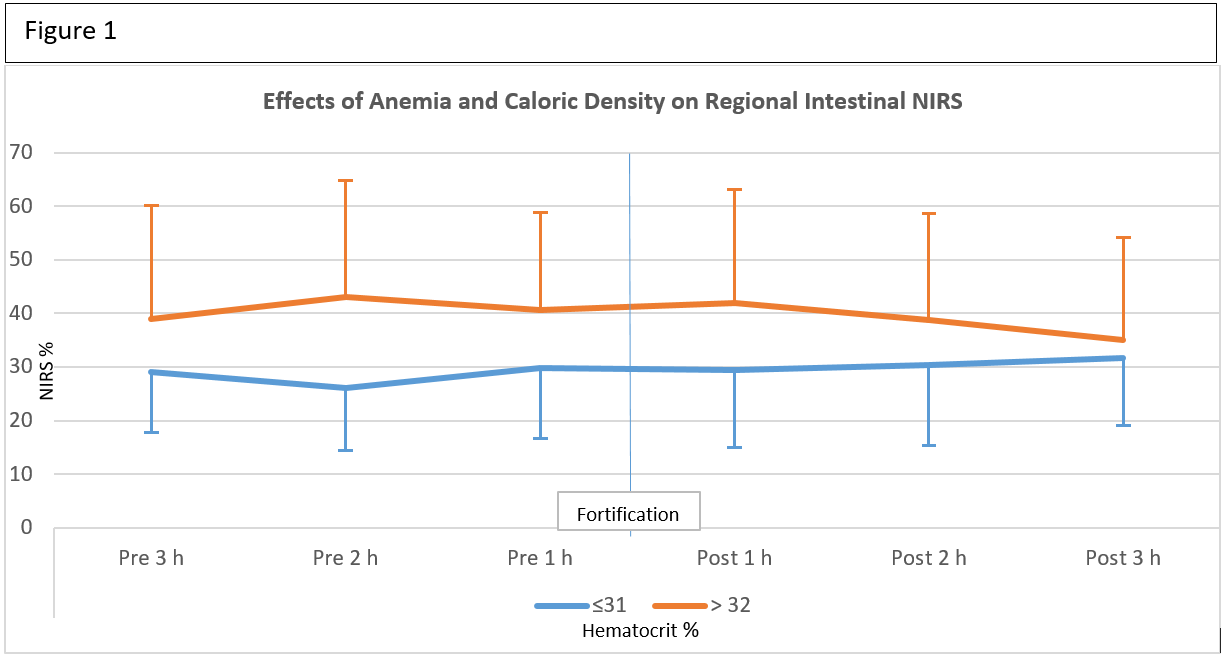Neonatal GI Physiology & NEC
Category: Abstract Submission
Neonatal GI Physiology & NEC III
504 - Effects of Anemia and Enteral Caloric Density on Regional Intestinal Oxygenation (rintestSO2) and Fractional Tissue Oxygen Extraction (FTOE) in Preterm Infants
Monday, April 25, 2022
3:30 PM - 6:00 PM US MT
Poster Number: 504
Publication Number: 504.426
Publication Number: 504.426
Max M. Shenberger, Maria Fareri Children's Hospital at Westchester Medical Center, Pomona, NY, United States; Boriana Parvez, Maria Fareri Children's Hospital at Westchester Medical Center, Valhalla, NY, United States; Edmund F. LaGamma, New York Medical College, Valhalla, NY, United States

Max M. Shenberger, MD, FAAP
Neonatal Fellow
Maria Fareri Children's Hospital at Westchester Medical Center
Valhalla, New York, United States
Presenting Author(s)
Background: Extreme anemia is identified as an independent risk factor for NEC. Enteral feeds are invoked as an additional risk since up to 70% of O2 is consumed in the gut mucosal layer for digestion and absorption. Preterm neonates are at higher risk for NEC due to a developmental delay in intestinal oxygenation regulatory mechanisms, particularly when anemic, and perhaps when presented with higher caloric and macronutrient amounts. Abdominal NIRS can be used to detect alterations of regional intestinal oxygenation. FTOE increases as a compensatory mechanism to maintain an adequate O2 delivery and consumption balance. We hypothesize that there will be a significant correlation between the degree of intestinal FTOE in anemic LBWs after fortification of enteral feeds.
Objective: To evaluate the effect of increased enteral caloric density on regional intestinal, cerebral & flank NIRS and FTOE + anemia in preterm neonates.
Design/Methods: Preterm newborns (divided in 2 groups based on Hct ≤31% vs >32%) had regional NIRS signals extracted every 5 sec, averaged every hour for 3h before & after fortification. Simultaneous pulse oximetry signals were recorded and FTOE was calculated ([SpO2-rintestSO2]/SpO2). Maternal and neonatal demographics and morbidities plus enteral volume and calories were collected.
Results: Subjects (n=14) were studied at similar corrected gestational ages (31wk) and postnatal weights (Table). Maternal and neonatal birth demographics or morbidities did not differ except for Hct (29±1 vs 36±5, p < 0.007). All infants were fed exclusive human milk diet with mothers’ and/or donor milk, fortified with human milk derived fortifier to 24 kcal/oz. The enteral feeds and calories at study time were the same both prior to and after fortification; all averaging < 100kcal/kg/d. Both groups had low rintestSO2 and high intestinal FTOE vs cerebral & flank (not shown), however the values in the low Hct group were significantly worse (Figure 1 & 2). Fortification did not produce the expected increase in rintestSO2 or change in FTOE.Conclusion(s): Our findings reveal low rintestSO2 and high FTOE even at < 120 kcal/kg/d (AAP recommendation) which is further exaggerated by anemia and not affected by volume or caloric density when exclusive human milk diet is utilized. Increased FTOE suggests that intestinal O2 delivery in anemic infants is approaching the critical O2 point, the limit of compensatory mechanisms to optimize intestinal oxygenation. We speculate that FTOE can be used to identify infants at risk for intestinal O2 delivery:consumption imbalance, which may aid in avoiding one mechanism associated with NEC.
Table.png) Perinatal Demographics and Clinical Features
Perinatal Demographics and Clinical Features
Figure 1 Effects of Anemia and Caloric Density on Regional Intestinal Oxygen Saturation
Effects of Anemia and Caloric Density on Regional Intestinal Oxygen Saturation
Objective: To evaluate the effect of increased enteral caloric density on regional intestinal, cerebral & flank NIRS and FTOE + anemia in preterm neonates.
Design/Methods: Preterm newborns (divided in 2 groups based on Hct ≤31% vs >32%) had regional NIRS signals extracted every 5 sec, averaged every hour for 3h before & after fortification. Simultaneous pulse oximetry signals were recorded and FTOE was calculated ([SpO2-rintestSO2]/SpO2). Maternal and neonatal demographics and morbidities plus enteral volume and calories were collected.
Results: Subjects (n=14) were studied at similar corrected gestational ages (31wk) and postnatal weights (Table). Maternal and neonatal birth demographics or morbidities did not differ except for Hct (29±1 vs 36±5, p < 0.007). All infants were fed exclusive human milk diet with mothers’ and/or donor milk, fortified with human milk derived fortifier to 24 kcal/oz. The enteral feeds and calories at study time were the same both prior to and after fortification; all averaging < 100kcal/kg/d. Both groups had low rintestSO2 and high intestinal FTOE vs cerebral & flank (not shown), however the values in the low Hct group were significantly worse (Figure 1 & 2). Fortification did not produce the expected increase in rintestSO2 or change in FTOE.Conclusion(s): Our findings reveal low rintestSO2 and high FTOE even at < 120 kcal/kg/d (AAP recommendation) which is further exaggerated by anemia and not affected by volume or caloric density when exclusive human milk diet is utilized. Increased FTOE suggests that intestinal O2 delivery in anemic infants is approaching the critical O2 point, the limit of compensatory mechanisms to optimize intestinal oxygenation. We speculate that FTOE can be used to identify infants at risk for intestinal O2 delivery:consumption imbalance, which may aid in avoiding one mechanism associated with NEC.
Table
.png) Perinatal Demographics and Clinical Features
Perinatal Demographics and Clinical FeaturesFigure 1
 Effects of Anemia and Caloric Density on Regional Intestinal Oxygen Saturation
Effects of Anemia and Caloric Density on Regional Intestinal Oxygen Saturation